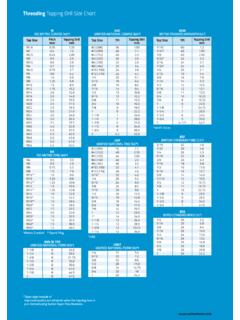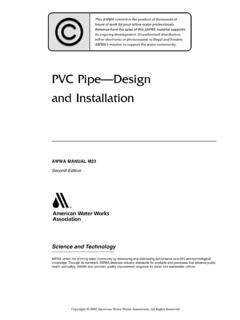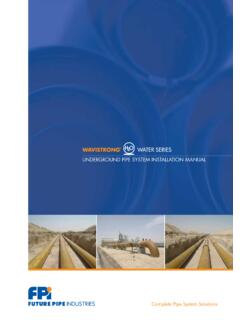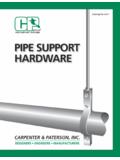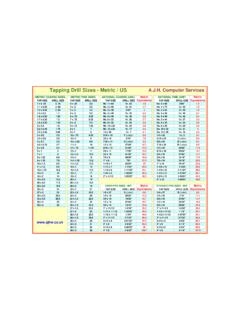Transcription of DESIGN OF DUCTILE IRON PIPE - McWane
1 DESIGN OF DUCTILE iron pipe With more than five decades of outstanding field experience, DUCTILE iron pipe is widely recognized as the industry standard for modernwater and wastewater of the most important reasons for the success of DUCTILE iron pipe is that, like Gray iron pipe before it, it is the subject of the mostextensive series of product standards in the pipe industry. Since the 1920s, American National Standards Institute now the AmericanWater Works Association Standards Committee A21 has been responsible for this series of standards on Gray and DUCTILE iron DUCTILE iron pipe was first introduced in 1955, the Standards Committee on DUCTILE iron pipe and Fittings has been provided withextensive data on trench loading tests, strength tests, corrosion resistance, tapping strength, flow characteristics, impact resistance,lining and joint integrity.
2 And virtually all aspects of the material that can affect its this data and the dedicated work of the members of AWWA Standards Committee A21, the American National Standard for the Thickness DESIGN of DUCTILE iron pipe (ANSI/AWWA C150 ) has evolved. No more thorough and comprehensive standarddesign procedure exists for any piping BasisThe basis of the DESIGN standard for DUCTILE iron pipe is the long-established fact that DUCTILE iron pipe , subjected to internal pressure and underground loading conditions, behaves as a flexible conduit and rerounds under pressure.
3 Therefore, the pipeis designed separately to withstand external loads and internal pressure. The result is more conservative than designing for thecombined loading condition. Thus the separate stress DESIGN approach was chosen as the basis of the original ANSI standard in , the DESIGN procedure for DUCTILE iron pipe for internal pressures (static pressure plus surge pressure allowance).2. DESIGN for bending stress due to external loads (earth load plus truck loads).3. Select the larger resulting net wall Add an service Check Add a standard casting procedure results in the total calculated DESIGN thickness, from which the appropriate pressure class is CriteriaThe Standards Committee carefully chose the following criteria in the 1976 standard for use in calculating required thickness of DuctileIron pipe .
4 These criteria remain unchanged in the current edition of the load is based upon the prism load concept, a very conservative assumption for loads normally experienced by a flexible loads are based upon a single AASHTO H-20 truck with 16,000 pounds wheel load and an impact factor of at all External load DESIGN includes calculation of both ring bending stress and deflection. Ring bending stress is limited to 48,000 psi,providing a safety factor of at least based upon ultimate bending of the pipe ring is limited to a maximum of 3 percent for cement-lined pipe . Again, this limit provides a safety factor of at least against applicable performance limits of the lining.
5 (Unlined pipe and pipe with flexible linings are capable ofwithstanding greater deflections.)5. Five trench types have been defined in the standard (see Figure 1 and Table 1) to give the designer a selection of laying conditions. This ensures a cost-effective trench section DESIGN for varying job Internal pressure DESIGN of standard pressure classes is based on rated working pressure plus a surge allowance of 100 psi. A safetyfactor of is applied to this calculation, which is based on a minimum yield strength in tension of 42,000 OF DUCTILE iron PIPEDESIGN OF DUCTILE iron PIPE1 Internal Pressure DesignThe net thickness required for internal pressure is calculated using the equation for hoop stress:The DESIGN internal pressure (Pi) is equal to the safety factor of times the sum of working pressure (Pw) plus surge allowance (Ps)for water pipe ; that is Pi= (Pw+ Ps).
6 The standard surge allowance of 100 psi is adequate for most applications; however, if anticipated surge pressures are other than 100 psi, the actual anticipated surge pressure should be Load DesignThe net wall thickness required for external load is based on two DESIGN considerations: limitation of ring bending stress and ringdeflection. When a trench load of sufficient magnitude is applied, DUCTILE iron pipe will deflect amply to develop passive resistancefrom the sidefill soil, thereby transmitting part of the trench load to the sidefill soil. Thus, the load-carrying capacity of DUCTILE Ironpipe is a function of soil and ring stiffness.
7 In addition, an upward reaction to the vertical trench load exerted on the pipe develops inthe trench embedment below the pipe . This reaction is distributed almost uniformly over the width of bedding of the pipe ; the greaterthe width of bedding, the greater the load-carrying capacity of the pipe . Therefore, certain DESIGN criteria dependent on the effectivewidth of bedding and on the available passive resistance of the sidefill soil are essential to calculating ring bending stress and ringdeflection of DUCTILE iron pipe . These DESIGN criteria have been conservatively established from test data for various standard layingconditions discussed later in this article.
8 (See Table 1.) Also, due to its inherent greater ring stiffness, DUCTILE iron pipe is less relianton soil support than other flexible pipe Stress DesignDesign maximum ring bending stress for DUCTILE iron pipe is 48,000 psi, which provides safety factors under trench loading of at least on ring yield strength and at least based on ultimate ring strength. The following equation is used to calculate the trench loadrequired to develop a bending stress of 48,000 psi at the pipe invert: Net Thickness and Service AllowanceA net thickness is computed using both the internal pressure and bending stress equations as described above.
9 The larger of the two netthicknesses is then selected as the net thickness required for internal pressure and bending stress service allowance ( for all pipe sizes) is then added to the larger net thickness. This service allowance provides an additionalsafety factor for unknowns. The resulting thickness is the minimum thickness CheckMaximum allowable ring deflection for cement-mortar-lined DUCTILE iron pipe is 3 percent of the outside diameter (5 percent forflexible linings). Tests have shown that 3 percent deflection will provide a safety factor of at least with regard to failure of thecement-mortar lining.
10 Much larger deflections can be sustained without damage to the pipe wall. The following equation is used tocalculate the trench load required to develop a ring deflection of 3 percent of the outside diameter. The t1required for deflection is compared to the t1resulting from internal pressure and bending stress DESIGN . The greater t1is usedand is called the minimum manufacturing f3(D)(D-1)t tKb- Kx8E + (D-1)3tPv= x/D12Kx8E + (D-1)3t1where:Pv= trench load, psi = Pe+ PtPe= earth load, psiPt= truck load, psif= DESIGN maximum bending stress, 48,000 psiD = outside diameter, = net thickness, bending moment coefficient (Table 1)Kx= deflection coefficient (Table 1)E = modulus of elasticity (24 x 106psi)E = modulus of soil reaction, psi (Table 1)where:t1= minimum thickness, in.
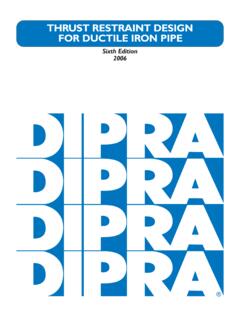


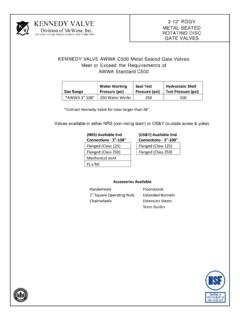
![Untitled-1 [pe.mcwane.com]](/cache/preview/0/6/a/a/7/a/e/3/thumb-06aa7ae3820fc1a116eff00b799cf8bf.jpg)
